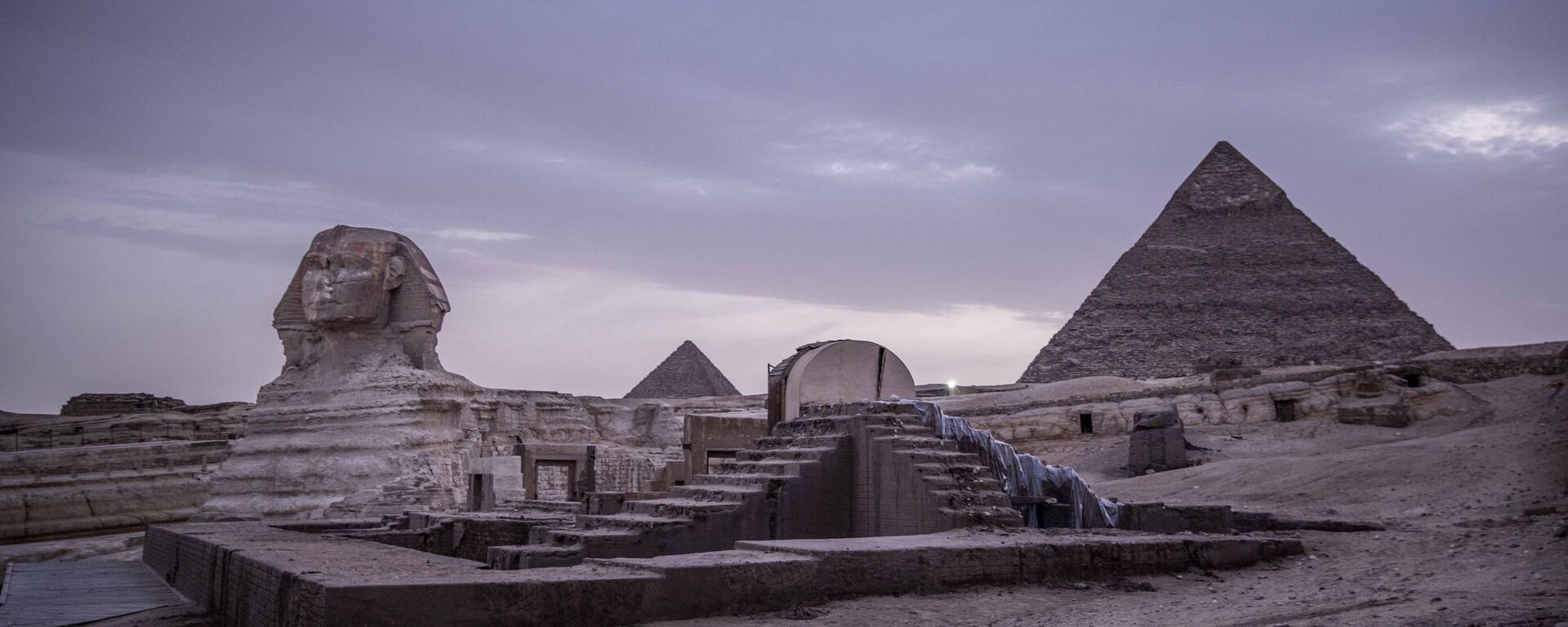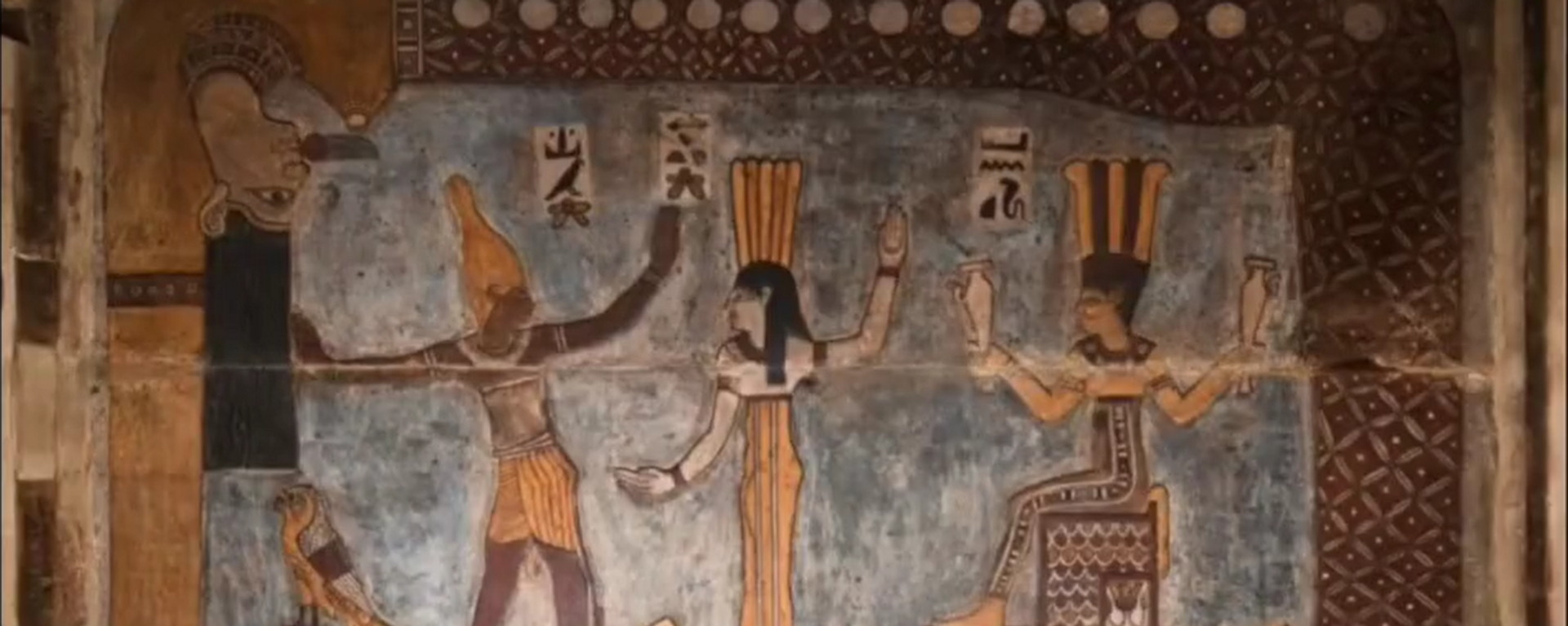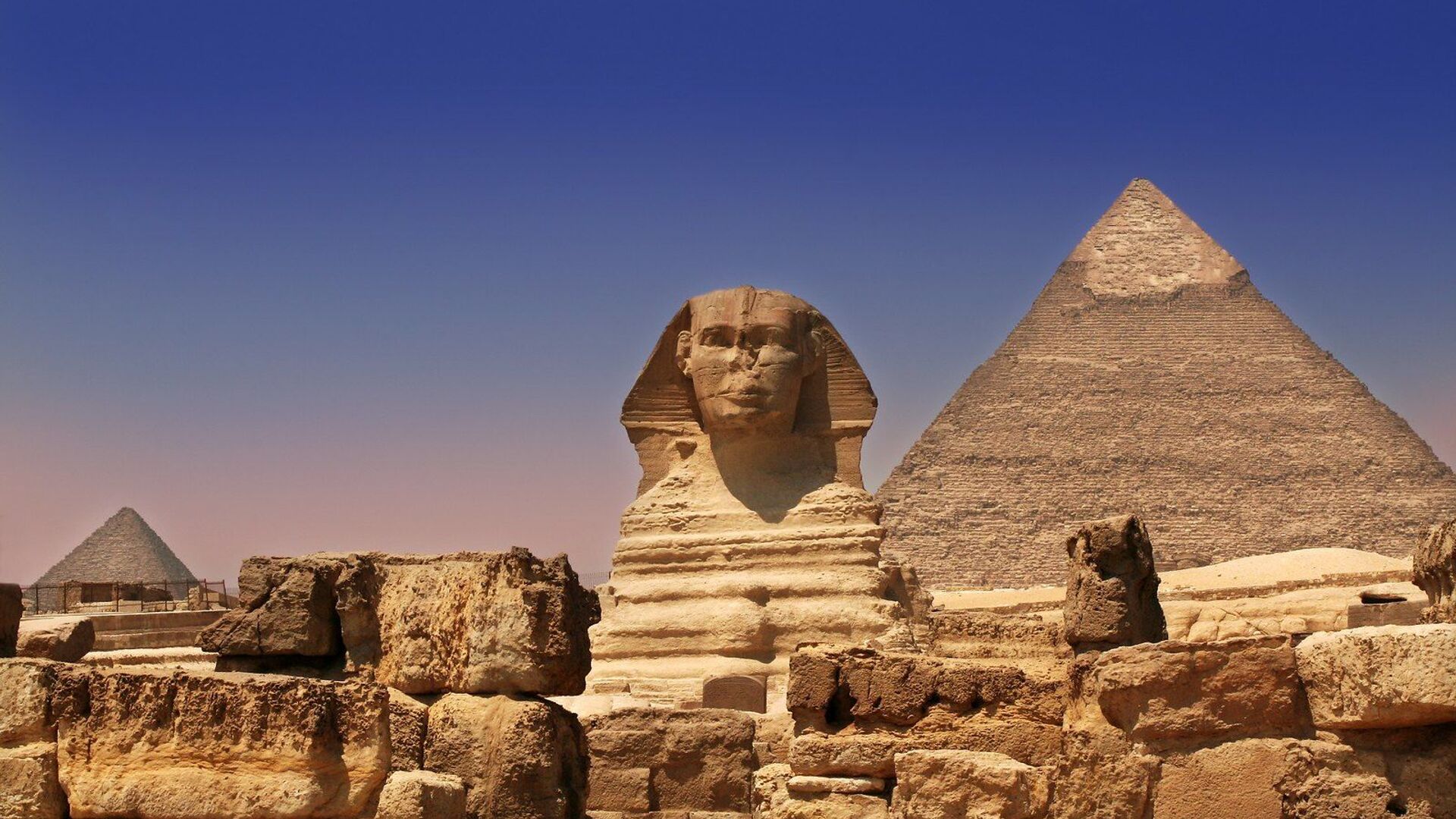https://sputnikglobe.com/20231114/murders-atlantis-and-infinite-knowledge-the-mind-blowing-mysteries-of-the-great-sphinx-1114906615.html
Murders, Atlantis and Infinite Knowledge: The Mind-blowing Mysteries of The Great Sphinx
Murders, Atlantis and Infinite Knowledge: The Mind-blowing Mysteries of The Great Sphinx
Sputnik International
The legend of the chamber lying beneath the Sphinx is thousands of years old. For generations, historians believed that some hidden heritage of the Egyptian civilization lies there. Sputnik can finally reveal the secrets of the ancient statue...
2023-11-14T09:17+0000
2023-11-14T09:17+0000
2023-11-14T09:17+0000
beyond politics
atlantis
egypt
greece
new york university
sputnik
https://cdn1.img.sputnikglobe.com/img/107580/31/1075803179_0:14:1601:914_1920x0_80_0_0_3c9af409d55b5d95fd613ed2942453d7.jpg
Most people have probably heard the riddle "What creature walks on four feet in the morning, two feet in the afternoon and three feet at night?" The puzzle was posed to Oedipus when Thebes was being tormented by the Sphinx, and when Oedipus answered correctly that the creature was man (crawling when a baby, walking upright when an adult and needing the help of a stick in old age), Thebes was saved and Oedipus was made its king, marrying in the process the newly widowed Jocasta, who turned out to be his mother.This tragic tale was turned into a play - Oedipus Tyrannus - by the Greek dramatist Sophocles but in this case the Sphinx is legendary as having the body of a lion, wings and a female head, a far cry from the massive Egyptian statue with which we are now so familiar. Furthermore, the Egyptian Sphinx’s puzzles are much more mysterious.A Century Old ScoopScientists have recently managed to unravel its mysteries. For many years, no one knew how the Egyptians built such a vast structure. Scholars at New York University have worked out that it was the wind that helped the ancient sculptors.The monument was originally a monolith (a single rock). Because of exposure to the air, the soft outer layer of limestone was gradually dispersed, eventually exposing solid rock. Later, craftsmen carved the sphinx’s features – torso, paws, and its graceful head.But delve a bit deeper and things become rather more complicated: connoisseurs of the weird and wonderful have been obsessing for ages what lies beneath the structure. Some believe that there are underground vaults housing great Egyptian treasures a so-called Hall of Records or a "crypt of civilization".Naturally, the Internet is rife with speculation and the online community really came alive when drone footage showed small holes with doors on the head and back of the Sphinx.It turned out that the drone footage was not quite as groundbreaking after all: Émile Baraize, a French Egyptologist and director of works at the Egyptian Antiquities Service, alerted the world to these holes almost a century ago, after conducting extensive excavations and restoration at the site between 1925 and 1936.Baraize discovered that the hol e on top was meant for a crown or some other headwear to be mounted and it led to a dead end. The hatch in the back led to a small empty chamber.The Frenchman kept numerous detailed diaries with drawings, but did not publish any of them and that is one reason speculation has never abated.Revelations Of A ClairvoyantThe legend concerning the Hall of Records has been around for millennia and there is the suggestion that it is not the Sphinx that should be explored but rather its immediate surroundings.Several wall records covering Egyptian temples have been deciphered to disclose that Thoth (the ancient Egyptian god of wisdom) gathered all existing knowledge and hid it somewhere in the valley of the pyramids.Herodotus, the Greek historian and geographer who is often referred to as 'The Father of History', wrote in the fifth century BC - roughly 2,500 years ago - about a network of underground tunnels in Giza. This allegation was later explored by neo-Platonic philosophers such as Iamblichus (245/280 to 325/330 A.D.) in his work 'De Mysteriis' ('On the Mysteries' [of the Egyptians, Chaldeans, and Assyrians]). It was further embraced by the members of the Hermes Trismegistus secret society in the Early Middle Ages.However, it was Coptic legends written down by Arab travelers that gave the greatest credibility to the secret room. The tales say that the interconnected underground passages, dug down from the three pyramids, lead to a single vast crypt - between the paws of the Great Sphinx.Getting there is no simple task. The entrance is guarded by keeper statues, which kill the intruders.Archaeologists during the 18th and 19th centuries from all over the world tried to get there - not a single one succeeded.The 20th century changed everything: Edgar Cayce, an American clairvoyant, gained incredible popularity in the Thirties by entering into a trance - leading to his being known as 'The Sleeping Prophet' - and attaining a higher state of existence during which he would be possessed by spirits who would "answer questions on a variety of subjects such as healing, reincarnation, the afterlife, past lives, Atlantis, and the future".Many of Cayce’s contemporaries were sceptical since most of his “predictions” often fell flat.The medium supposedly looked into the Hall of Records under one of the sphinx’s paws. He revealed that the crypt contained the legacy of Atlantis, the legendary advanced civilization that eventually fell foul of the gods and was swallowed by the Atlantic Ocean.Not The Whole TruthFor decades, Cayce's pronouncements were taken with more than a pinch of salt. But in 1989, (43 years after Cayce's death in 1945) Japanese scientists from Waseda University in Tokyo excavated the paws of the sphinx and found a small tunnel under the left one, about three or four meters deep.Shortly after, American geophysicist Thomas Dobecki conducted a seismological scan and discovered that the corridor led to sealed chambers. However, the Egyptian authorities intervened and banned all further research in the area near the monument.Like the Sphinx herself, the nearer one seems to get to the mystery of the monument, the further the truth recedes, forever eluding inspection.However, a few years later Zahi Abass Hawass - an Egyptian archaeologist, Egyptologist, and former Minister of State for Antiquities Affairs - stepped in and adopted a creative approach. Since it is impossible to dig in the vicinity of the Sphinx, he has illuminated the whole area with geodetic radar.Thanks to his intervention, it has now been revealed that there is, in fact, a small network of galleries and chambers underground. But, greatly to the chagrin of adventurers, they are all empty. The radar has not picked up any solid object.But Hawass has always maintained that Egypt’s secrets are endless - perhaps the mystery of The Hall of Records is still waiting to be revealed.
https://sputnikglobe.com/20220123/archeologists-uncover-two-giant-sphinxes-built-3300-years-ago-1092457837.html
https://sputnikglobe.com/20231020/colorful-egyptian-new-years-scene-uncovered-during-restoration-of-ancient-temple-1114341733.html
atlantis
egypt
greece
Sputnik International
feedback@sputniknews.com
+74956456601
MIA „Rossiya Segodnya“
2023
Sputnik International
feedback@sputniknews.com
+74956456601
MIA „Rossiya Segodnya“
News
en_EN
Sputnik International
feedback@sputniknews.com
+74956456601
MIA „Rossiya Segodnya“
Sputnik International
feedback@sputniknews.com
+74956456601
MIA „Rossiya Segodnya“
legend of the chamber lying beneath the sphinx, egyptian civilization, ancient statue
legend of the chamber lying beneath the sphinx, egyptian civilization, ancient statue
Murders, Atlantis and Infinite Knowledge: The Mind-blowing Mysteries of The Great Sphinx
The legend of the chamber lying beneath the Sphinx is thousands of years old. For generations, historians believed that some hidden heritage of the Egyptian civilization lies there. Sputnik can finally reveal the secrets of the ancient statue...
Most people have probably heard the riddle "What creature walks on four feet in the morning, two feet in the afternoon and three feet at night?" The puzzle was posed to Oedipus when Thebes was being tormented by the Sphinx, and when Oedipus answered correctly that the creature was man (crawling when a baby, walking upright when an adult and needing the help of a stick in old age), Thebes was saved and Oedipus was made its king, marrying in the process the newly widowed Jocasta, who turned out to be his mother.
This tragic tale was turned into a play - Oedipus Tyrannus - by the Greek dramatist Sophocles but in this case the Sphinx is legendary as having the body of a lion, wings and a female head, a far cry from the massive
Egyptian statue with which we are now so familiar. Furthermore, the Egyptian Sphinx’s puzzles are much more mysterious.
Scientists have recently managed to unravel its mysteries. For many years, no one knew how the Egyptians built such a vast structure. Scholars at New York University have worked out that it was the wind that helped the ancient sculptors.
The monument was originally a monolith (a single rock). Because of exposure to the air, the soft outer layer of limestone was gradually dispersed, eventually exposing solid rock. Later, craftsmen carved the sphinx’s features – torso, paws, and its graceful head.
But delve a bit deeper and things become rather more complicated: connoisseurs of the weird and wonderful have been obsessing for ages what lies beneath the structure. Some believe that there are underground vaults housing great Egyptian treasures a so-called Hall of Records or a "crypt of civilization".
Naturally, the Internet is rife with speculation and the online community really came alive when drone footage showed small holes with doors on the head and back of the Sphinx.
It turned out that the drone footage was not quite as groundbreaking after all: Émile Baraize, a French Egyptologist and director of works at the Egyptian Antiquities Service, alerted the world to these holes almost a century ago, after conducting extensive excavations and restoration at the site between 1925 and 1936.
Baraize discovered that the hol e on top was meant for a crown or some other headwear to be mounted and it led to a dead end. The hatch in the back led to a small empty chamber.
The Frenchman kept numerous detailed diaries with drawings, but did not publish any of them and that is one reason speculation has never abated.

23 January 2022, 00:42 GMT
Revelations Of A Clairvoyant
The legend concerning the Hall of Records has been around for millennia and there is the suggestion that it is not the Sphinx that should be explored but rather its immediate surroundings.
Several wall records covering Egyptian temples have been deciphered to disclose that Thoth (the ancient Egyptian god of wisdom) gathered all existing knowledge and hid it somewhere in the valley of the pyramids.
Herodotus, the Greek historian and geographer who is often referred to as 'The Father of History', wrote in the fifth century BC - roughly 2,500 years ago - about a network of underground tunnels in Giza. This allegation was later explored by neo-Platonic philosophers such as Iamblichus (245/280 to 325/330 A.D.) in his work 'De Mysteriis' ('On the Mysteries' [of the Egyptians, Chaldeans, and Assyrians]). It was further embraced by the members of the Hermes Trismegistus secret society in the Early Middle Ages.
However, it was Coptic legends written down by Arab travelers that gave the greatest credibility to the secret room. The tales say that the interconnected underground passages, dug down from the three pyramids, lead to a single vast crypt - between the paws of the
Great Sphinx.
Getting there is no simple task. The entrance is guarded by keeper statues, which kill the intruders.
Archaeologists during the 18th and 19th centuries from all over the world tried to get there - not a single one succeeded.
The 20th century changed everything: Edgar Cayce, an American clairvoyant, gained incredible popularity in the Thirties by entering into a trance - leading to his being known as 'The Sleeping Prophet' - and attaining a higher state of existence during which he would be possessed by spirits who would "answer questions on a variety of subjects such as healing, reincarnation, the afterlife, past lives, Atlantis, and the future".
Many of Cayce’s contemporaries were sceptical since most of his “predictions” often fell flat.
The medium supposedly looked into the Hall of Records under one of the sphinx’s paws. He revealed that the crypt contained the legacy of Atlantis, the legendary advanced civilization that eventually fell foul of the gods and was swallowed by the Atlantic Ocean.
For decades, Cayce's pronouncements were taken with more than a pinch of salt. But in 1989, (43 years after Cayce's death in 1945) Japanese scientists from Waseda University in Tokyo excavated the paws of the sphinx and found a small tunnel under the left one, about three or four meters deep.
Shortly after, American geophysicist Thomas Dobecki conducted a seismological scan and discovered that the corridor led to sealed chambers. However, the Egyptian authorities intervened and banned all further research in the area near the monument.
Like the Sphinx herself, the nearer one seems to get to the mystery of the monument, the further the truth recedes, forever eluding inspection.
However, a few years later Zahi Abass Hawass - an Egyptian archaeologist, Egyptologist, and former Minister of State for Antiquities Affairs - stepped in and adopted a creative approach. Since it is impossible to dig in the vicinity of the Sphinx, he has illuminated the whole area with geodetic radar.

20 October 2023, 03:54 GMT
Thanks to his intervention, it has now been revealed that there is, in fact, a small network of galleries and chambers underground. But, greatly to the chagrin of adventurers, they are all empty. The radar has not picked up any solid object.
But Hawass has always maintained that Egypt’s secrets are endless - perhaps the mystery of The Hall of Records is still waiting to be revealed.




